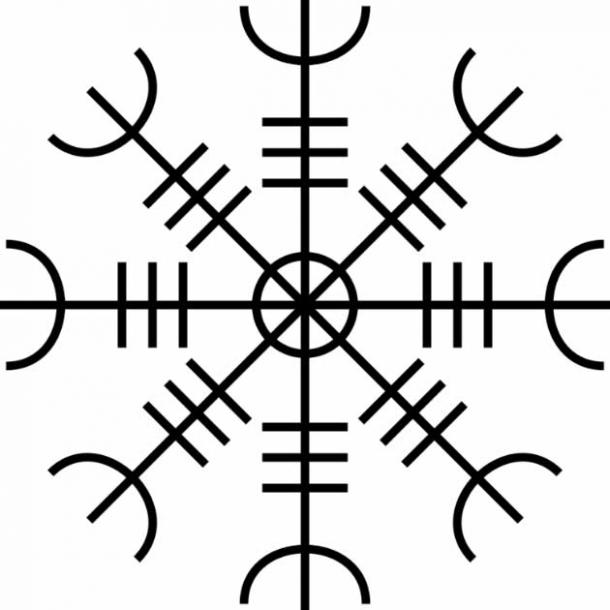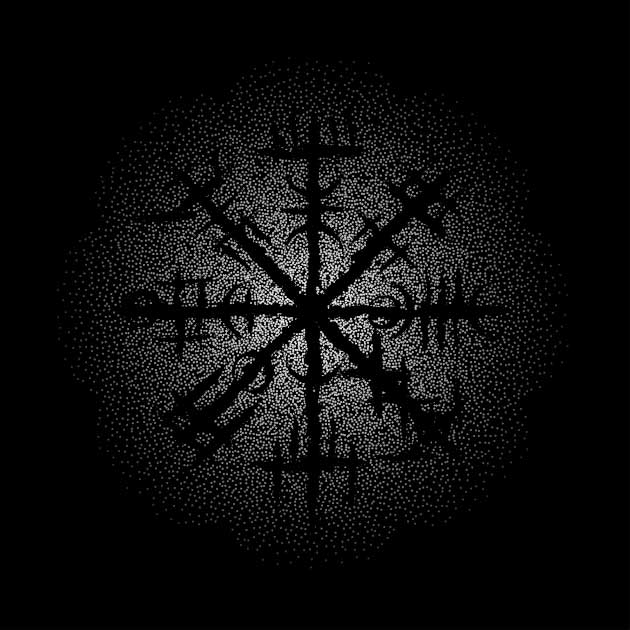
What is the Helm of Awe? Runes, Symbols, and Viking Magic!
Every culture contains a plethora of images, animals, foods, etc. that are symbolic of their values. Symbols are an important, meaningful aspect of culture that can teach historians, archaeologists, and other scholars a great deal about specific groups of people. They also grow and change over time, their meaning evolving as society changes, and not always for the better. The Helm of Awe is one such symbol. What did it mean to the Icelandic cultures from whence it came, and what does it mean now?
The Helm of Awe: For Magical Practitioners and Spells
The Nordic religion believed in the existence of magic, which they called Seidr. In fact, the Völva (Viking age women who practiced magic) predate the Viking Age. In Norse culture, they were wielders of magic powers and acted as healers or spiritual leaders. The Völva were marked by their clothing; they wore colorful dresses, gloves, and fur hats, and carried some form of staff or wand with them to aid in the performance of spells. However, it must be noted that it was rare for men to practice magic as Völvas because it was considered unmanly or had non-warrior connotations.
- Return of the Ancient Gods: The Resurgence of Paganism
- The Myth of National Socialism: How the Nazis Distorted the Nordic Past
The Völva could put themselves into trances, aided by singing and drums, and then walk between this world and the spiritual world to commune with spirits and make prophecies. They could also wield powerful magic to put a curse on someone to make them ill or ineffective in battle in myriad ways. While the spells of the Viking Age were not likely written down during their time, they were eventually collected into books that we now refer to as grimoires. Few of these containing Viking spells have survived the ages, but in those that have, we find the Helm of Awe.

The Helm of Awe or Helm of Terror is symbolic of a "vague artifact" described in the ancient pages of Norse mythology that also functioned as a form of magic, spell, or incantation. (Dbh2ppa / Public domain)
The Helm of Awe: Physical Object or Spell?
One of the earliest references to the Helm of Awe seems to refer to it as a physical object. In the Poetic Edda (a collection of ancient Norse narrative poetry), the dragon Fafnir was said to have “[worn the helm] before the sons of men” and while wearing it, “found no power a match for my own.” The hero Sigurd took the helm after slaying Fafnir, leading scholars to believe that this portion of Fáfnismál (the poem from which the quotes were pulled [see references]) is discussing an actual, physical helmet. But there are those who disagree.
Many scholars believe that the Helm of Awe was never a physical object, but rather a rune spell, or stave (bearing in mind that “helm,” or hjálmr actually meant “covering,” and so could be thought of as a sort of protective shielding as much as physical armor) . In some collections of folklore and grimoires, there exists the image of a rune spell named Ægishjálm. The spell is said to be an amalgam of two runes: Z-runes, believed to provide protection against an enemy, and Isa runes, which translates to ice and is believed to be designed to harden one’s will against a foe. Put together, the purpose of the Ægishjálm spell seems to have been to shield a warrior from attack while allowing him to overpower his foe. Though there is no academic certainty that these are the runes they are seeing, this interpretation aligns nicely with the story of Sigurd and Fafnir.

This modern grunge rune image is actually the Helm of Awe, a symbol that has remained alive since it was supposedly created with magic. (longquattro / Adobe Stock)
What Does the Helm of Awe Mean? Then versus Now
Scholars posit that the Helm of Awe could be used in different ways, depending on the caster’s purpose. It could be used subjectively to cover oneself with a protective shield, or objectively to transform (Fafnir was a dwarf who used the helm to change into a dragon). The number of arms drawn on the rune equates to different realms of magic and directions (the four cardinal directions) on the earthly plane.
According to ancient sources, the Ægishjálm rune was to be cast in lead and then imprinted on the forehead of anyone believing a fight was heading their way. When broken down, the root of the word translates to “terror;” in its entirety, it means helm of terror, or helm of awe.
The Helm of Awe symbol is representative of the ability to strike fear into your enemy and can be conceived of as a magical shield. Over time, however, the symbol has been used elsewhere and new meanings have appeared.
- Neopagans in Iceland Will Build the First Temple to Thor and Odin in 1000 Years
- The long goodbye to Scandinavian Paganism and the Christianization of three realms
In recent history, the Ægishjálm rune has been used by far-right nationalist groups as a symbol of power and fear. The Party of the Swedes used the rune as the official symbol of their party, describing it as a symbol of “both life and death,” and as being representative of their intention to make the “establishment…fear the party.” The text from their party website (now defunct [see references: Olsson]) states that the rune is part of the cultural identity of Sweden and that its warrior connotations mesh well with their political goals.
As such, the helm has become a flashpoint symbol in the struggle between the left and right wings of political ideology. Its meaning has not changed so much as the purpose for which it is being used.
Ultimately, the Helm of Awe has historical roots tracing back to the Viking Age (and possibly beyond). A magical spell that could give the wielder extraordinary protection in battle, the Ægishjálm rune was part of a complex Nordic religion and culture that endured for centuries.
Its meaning, like that of any symbol, is prone to shift and change at the hands of those who would co-opt it for their own purposes. Where once it was a protective spell, it has now become a symbol of nationalist ideology. But who knows what it might mean tomorrow?
Top image: The Nordic Helm of Awe is a Viking or Norse magical spell or rune that could be used for good or evil, but it wasn’t an actual battle helmet. Source: Fotokvadrat / Adobe Stock
By Mark Johnston
References
McCoy, D. n.d. The Helm of Awe. Available at: https://norse-mythology.org/symbols/helm-of-awe/.
Olsson, S. 2020. The Battle for the Runes: A Discussion Analysis of the Social Debate Around the Tyr Rune and the Horror Helmet (Translated). Available at: https://www.diva-portal.org/smash/record.jsf?pid=diva2%3A1386001&dswid=387.
Skjalden. 2021. The Helm of Awe. Available at: https://skjalden.com/helm-of-awe/amp/.
Skjalden. 2018. Völva the Viking Witch or Seeress. Available at: https://skjalden.com/volva-the-viking-witch-or-seeress/.















